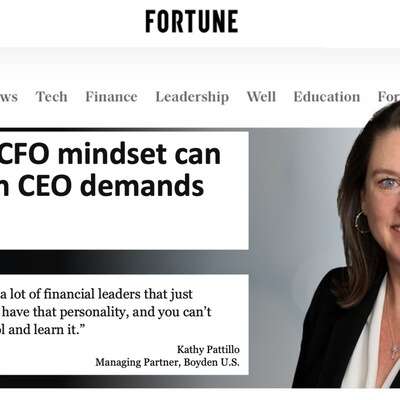There’s no question that the traditional C-suite is no match for today’s shifting business imperatives. In this recent article published in Senior Executive, Boyden Atlanta’s Dan Grassi talks about what changes are needed for the C-suite to meet this shifting landscape and build efficient and progressive organizations.
Originally published in Senior Executive
Chief customer officer. Chief brand engagement officer. Chief people officer. Chief innovation officer. Chief sustainability officer. These titles and others have been welcomed into C-suites, particularly in the Fortune 500. Smaller companies and startups are more recently embracing the trend — transforming their leadership teams with new roles that address today and tomorrow’s priorities.
And priorities are shifting, with many changes accelerated by the pandemic. Streamlining decision-making, creating new roles for changing market imperatives and developing more horizontal responsibilities are all on CEOs’ agendas, according to 2021 research from consulting firm EY. These changes all have the power to transform the C-suite.
“What we’re finding is a lot of ‘aha’ moments for companies today in looking at their leadership teams and trying to determine, is this the right team for the future?” says Emily Neill, senior managing director of the executive search practice at Robert Half.
See what’s shifting in the C-suite, and how your team should respond.
So, What’s Happening to C-level Titles?
LinkedIn’s Workforce Insights team analyzed more than 100,000 hiring decisions in the U.S. that incorporated the word “chief,” and found 51 variations. From September 2020 to August 2021, titles experiencing the most growth included chief diversity and inclusion officer, chief underwriting officer and chief people officer. The following titles also ranked among the top 10 for the fastest growth in both 2020 and 2021:
- Chief growth officer.
- Chief revenue officer.
- Chief customer officer.
- Chief legal officer.
- Chief talent officer.
Companies are also expanding or reshaping existing roles to address key focus areas. In technology and information security departments — for example — risk, compliance and data protection functions have become more prominent.
“As the scope of compliance leadership roles has expanded, so too have the titles used to describe them,” says Samantha Kelen, chief compliance officer at Stellar Health. “In addition to chief compliance officer and chief ethics and compliance officer, I’ve also come across other creative options, such as chief integrity officer or conduct risk officer.”
In other cases, compliance roles can be combined with other priority areas. That can include legal or environmental, social and governance departments. Stellar Health, a growing company with 130 employees, hired Kelen as its first chief compliance officer in January 2022.
The trend also holds true in marketing, says Neill. Niche titles adjacent to or within the marketing function are added to address specific needs. For example, unique from the traditional chief marketing officer, a chief brand officer has a keen understanding of how to elevate or change a brand. Similarly, a chief storytelling officer is brought on to help a company communicate its journey more effectively.
Another area experiencing leadership growth is the people function. Chief happiness officers, chief people officers and chief human resources officers are all becoming more common. A separate title, chief wellness officer, is sometimes reserved for larger companies that are rolling out entire programs focused on employee wellbeing. Having someone who’s focused on wellness will be critical for companies moving forward, Neill says: “Good employees and ones that want to stay with a company are ones who are well, and ones who feel like their company really cares about them as a person.” At smaller companies, this role might fall under benefits or human resources.
“The title game is one that is constantly evolving,” reminds Neill. “There are so many different titles out there. It depends greatly on how that company decides to title the roles.” These decisions are based on a variety of factors, including a company’s size and the scope of the position. A C-level role at one company might be a vice president or regional manager position at another.
Even with so many emerging leadership roles, EY’s research identified two gaps where new C-suite positions could be of benefit: ecosystem orchestration and culture. CEOs see the value in investing in ecosystems, which create partnerships both within the business and externally. However, ecosystem building is not often linked to strategy. “They [ecosystem initiatives] don’t have one person who’s a clear owner,” says John de Yonge, senior analyst at EY’s Research Institute.
Further, EY’s study found a lack of cultural clarity. Less than one-third of CEOs thought their mid-level managers modeled a shared purpose and vision. “Given the importance of culture…isn’t it time to potentially appoint a chief culture officer?” de Yonge suggests.
So, Do You Need to Add to Your C-suite?
Evaluate your existing team, and identify any gaps that prevent you from hitting your KPIs. “If I don’t feel I can get there with what I have, what do I need to bring in to make that happen?” says Dan Grassi, managing partner at executive search firm Boyden.
Even if a weak spot isn’t an immediate threat, you can bring someone in and get ahead of the challenge. “You always need to be thinking ahead,” Grassi says. “It’s difficult to come from behind.”
Diversity should also be a consideration in C-suite transformations, de Yonge says. CEOs ranked increased diversity and bringing in external talent lower on their lists of priorities, according to EY research. That oversight can be a mistake.
“For companies across the board, diversity hires at a senior level are critically important,” Grassi agrees. “You want to make sure that your organization has the diverse makeup of what America looks like and what America wants.” Equally as important, Grassi notes, is hiring the right experience level and culture fit for the leadership position — not hiring just to hire.
Reflecting on interactions with CEOs during EY’s research, de Yonge says, the ability for leadership teams to react quickly to changing market imperatives is highly valued. When bringing someone new into your team, consider how it will affect your team’s decision-making agility and how it will advance horizontal decision-making.



